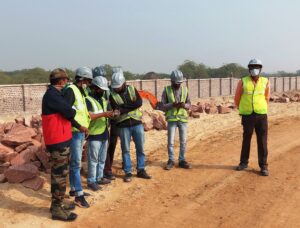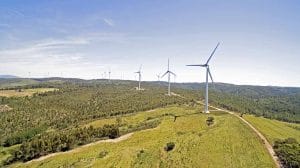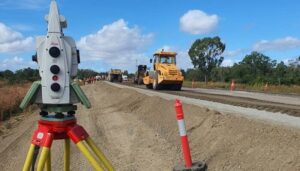In an era where urbanization is growing rapidly and climate change is an ever-present concern, finding efficient solutions for monitoring environmental impacts in cities is crucial. Urban areas, especially, are prone to the “urban heat island” effect, where temperatures in cities are significantly higher than in surrounding rural areas due to human activities, infrastructure, and lack of green spaces. This rising heat contributes to energy consumption, air pollution, and health issues for city residents. Here, drones have emerged as a powerful tool in urban heat mapping and climate analysis, providing accurate data that helps urban planners and policymakers address these challenges effectively.
Garud Survey Private Limited leverages drone technology to monitor, analyze, and provide actionable insights for sustainable urban planning and climate resilience.
Understanding the Urban Heat Island Effect
The urban heat island (UHI) effect describes how metropolitan areas become warmer than their rural counterparts, largely due to human infrastructure such as roads, buildings, and factories. As cities develop, natural landscapes like forests, rivers, and grasslands are often replaced by buildings and streets, which absorb and retain heat. Additionally, vehicle emissions, industrial activities, and high energy consumption amplify the UHI effect, making cities warmer, especially during the summer.
Excessive urban heat contributes to various issues, from increased energy demands for cooling to heightened levels of pollution and heat-related illnesses. Effective heat mapping can be instrumental in identifying areas most affected, leading to more informed and targeted strategies to mitigate these impacts.
Role of Drones in Urban Heat Mapping
Drones equipped with thermal imaging sensors have transformed the approach to urban heat mapping by providing accurate, high-resolution data that can be collected quickly and at a fraction of the cost of traditional methods. Here are some ways drones make a significant impact:
- Precision and Detail in Data Collection
Drone-based heat mapping can capture temperature variations at high resolutions, revealing temperature differences across specific locations, buildings, and even floors. This precision allows urban planners to pinpoint exact areas where temperatures are highest, enabling them to design interventions like green roofs, reflective building materials, or tree-lined streets to reduce heat in targeted zones. - Real-Time Data for Responsive Decision-Making
Unlike satellite imaging, which is often limited by weather conditions and scheduling constraints, drones can be deployed at any time and multiple points throughout the day. This flexibility provides real-time data, which is invaluable for urban planners and climate analysts seeking to make timely decisions, especially during heat waves or extreme weather conditions. - Cost-Effective Solutions
Traditionally, urban heat mapping was carried out via satellite imaging or on-ground surveys, both of which could be time-consuming and costly. Drones offer a cost-effective alternative, reducing the need for extensive manpower and expensive equipment while still producing high-quality data. This cost-efficiency allows cities to conduct regular heat mapping without straining budgets, supporting continuous climate monitoring and analysis. - 3D Heat Mapping and Detailed Spatial Analysis
Drones enable the creation of detailed 3D models of urban landscapes that include both surface and atmospheric temperatures. By combining thermal imaging with LiDAR (Light Detection and Ranging) technology, drones can capture data not only at ground level but also at varying heights, giving analysts insights into how heat behaves across different building levels and structural layouts. This 3D perspective is particularly valuable in densely populated areas with diverse architectural designs. - Climate Analysis and Monitoring Over Time
Regular drone flights allow for longitudinal climate data collection, which is essential for tracking temperature changes over time. These records help researchers and policymakers observe trends, evaluate the effectiveness of implemented measures, and adjust strategies based on evolving climate patterns.
Applications and Benefits of Drone-Based Heat Mapping
The integration of drones in urban heat mapping offers numerous benefits beyond simply identifying hot spots. Some of the primary applications and advantages include:
- Urban Planning and Green Space Allocation
With precise data on heat-affected areas, urban planners can make informed decisions on where to allocate green spaces, parks, and water bodies, which help in naturally cooling the urban environment. The strategic placement of greenery not only reduces temperatures but also improves air quality and enhances residents’ well-being. - Improved Building Design
Heat mapping allows architects and builders to identify areas of buildings most exposed to solar radiation. This data can inform designs that incorporate reflective materials, shaded areas, and other heat-mitigating structures, ultimately reducing energy costs for air conditioning. - Health and Safety Monitoring
In areas prone to extreme heat, drone data can help authorities identify vulnerable populations and regions. This insight is crucial for implementing heat-warning systems, preparing health services, and designing emergency response plans, which can mitigate the impact of heat waves on public health. - Supporting Policy and Public Awareness
Urban heat mapping provides a tangible way to present the impact of the UHI effect to the public and policymakers. Data gathered by drones can be visualized to show temperature differences and hot spots across the city, making it easier to raise awareness about the importance of climate resilience and sustainable urban planning.
The Future of Drones in Climate Analysis
As climate challenges intensify, the role of drones in environmental monitoring is likely to expand. Future developments could include AI-enhanced analysis, which would allow drones to process data and identify trends autonomously, providing even faster insights for decision-makers. Additionally, as drone technology advances, it will be possible to cover larger areas, gather more comprehensive data, and conduct climate analysis more frequently and efficiently.
Conclusion
Drones have proven to be invaluable tools in addressing the urban heat island effect through precise, cost-effective heat mapping and climate analysis. By enabling data-driven decision-making, drones support urban planners, policymakers, and environmental agencies in creating healthier, more resilient cities. Garud Survey Private Limited is committed to leveraging this cutting-edge technology to promote sustainable urban development and mitigate the impact of climate change on our cities. With continuous advancements in drone technology, the future of urban climate resilience looks promising, and we are proud to be at the forefront of this transformation.




